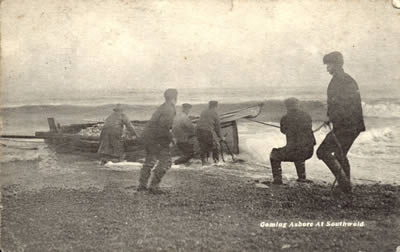Southwold's
Beach Companies |
"Coming
Ashore at Southwold" with a little help from your friends -
Landing a heavy boatloat of sprats
How do you launch unwieldy fishing boats from the shoreline – and beach them again, laden with a full catch? This ticklish task required several pairs of hands and, to achieve it, the fishermen joined in loose working groups that subsequently became Beach Companies. Beachmen could supplement their fishing earnings by piloting vessels, provisioning ships, ferrying passengers and salvaging wrecks. Southwold’s beachmen were also called cliffmen. Three sections of the cliffs – New York Cliff, Long Island Cliff and North Cliff or Kilcock Cliff (going south to north) gave their names to the beach companies. You can trace Beach Companies at Southwold back to the late 18th century. Trinity pilots and publicans held shares in the Companies (for example, the publican of the Pilot Boat Tavern had a half share in one yawl). In time the men owning the boats held all the shares. Around 1850, meetings of the North Cliff Company were held in the Lord Nelson, and their boat was the Nelly. Each Company had its own pilot house or communal watch tower. The Long Island Cliff House was at the end of East Street, the North Cliff house was below St James Green. James Maggs records in his diary that a New York Cliff House existed in 1760 but no information remains as to when and by whom it was built. The origin of these American place names is still shrouded in mystery. The boats used by the Beach Companies were mainly yawls and gigs. The North Cliff Company had a yawl, Swiftsure, in 1847; by 1850 the gigs Cricketer, Mayflower and Covehithe had been added. In 1851 a new yawl was built, the Friendship, paid for by public subscription. In 1810 the Long Island Company owned a 50-foot yawl, the Jubilee. While most of the Companies’ work was pilotage, there were other ways to make money. In 1814 Maggs recorded, from an account in the coxswain’s own hand, an incident in which they recaptured a ship from the old enemy: they ‘…retoke a Collier Brig with Jubilee Pilot Boat, from a French luger, Ben a Bout 3 miles a Heat Put 5 Frenchmen on Shore at Southwold it came on to Blow at N E and I toke the Brig to Harwich. W Woodward…’ Sadly, salvage rights often took precedence over saving the lives of sailors and passengers. And sometimes Companies’ eagerness cost them dearly. In 1856 two Companies launched their yawls Swiftsure and Reliance to salvage a ship in trouble. On going alongside, the Swiftsure cut the Reliance in half. The resulting legal wrangle was long and complex.
|
